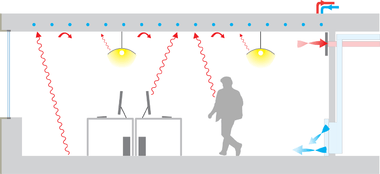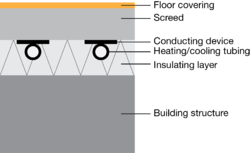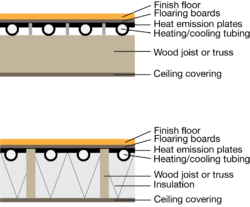Radiant heating and cooling system

A radiant heating and cooling system refers to temperature-controlled surfaces that exchange heat with their surrounding environment through convection and radiation. By definition, in radiant heating and cooling systems, thermal radiation covers more than 50% of heat exchange within the space.[1] Hydronic radiant heating and cooling systems are water-based. It refers to panels or embedded building components (floors, ceilings or walls). Other types include air-based and electrical systems (which use electrical resistance for heating purpose mainly). Important portions of building surfaces are usually required for the radiant exchange.
Applications
Radiant heating and cooling systems can be used in commercial, residential, education, and recreational buildings, museums, hospitals, and other type of buildings. The application depends on the type of radiant system (see below types of radiant systems), on climate conditions and on ventilation system used.
System description
Radiative heat exchange
Heat radiation is the energy in the form of electromagnetic waves emitted by a solid, liquid, or gas as a result of its temperature.[2] In buildings, the radiant heat flow between two internal surfaces (or a surface and a person) is influenced by the emissivity of the heat emitting surface and by the view factor between this surface and the receptive surface (object or person) in the room.[3] The heat transfer by radiation is proportional to the power of four of the absolute surface temperature.
The emissivity of a material (usually written ε or e) is the relative ability of its surface to emit energy by radiation. A black body has an emissivity of 1 and a perfect reflector has an emissivity of 0.[2]
In radiative heat transfer, a view factor quantifies the relative importance of the radiation that leaves an object (person or surface) and strikes another one, considering the other surrounding objects. In enclosures, radiation leaving a surface is conserved, therefore, the sum of all view factors associated with a given object is equal to 1. In the case of a room, the view factor of a radiant surface and a person depend on their relative positions. As a person is often changing position and as a room might be occupied by many persons at the same time, diagrams for omnidirectional person can be used.[4]
Operative temperature and thermal comfort
The operative temperature is an indicator of thermal comfort which takes into account the effects of both convection and radiation. Operative temperature is defined as a uniform temperature of a radiantly black enclosure in which an occupant would exchange the same amount of heat by radiation plus convection as in the actual nonuniform environment.
With radiant systems, thermal comfort is achieved at warmer interior temp than all-air systems for cooling scenario, and at lower temperature than all-air systems for heating scenario.[5] Thus, radiant systems can helps to achieve energy savings in building operation while maintaining the wished comfort level.
Radiant temperature asymmetry
The radiant temperature asymmetry is defined as the difference between the plane radiant temperature of the two opposite sides of a small plane element. As regards occupants within a building, thermal radiation field around the body may be non-uniform due to hot and cold surfaces and direct sunlight, bringing therefore local discomfort. The norm ISO 7730 and the ASHRAE 55 standard give the predicted percentage of dissatisfied occupants (PPD) as a function of the radiant temperature asymmetry and specify the acceptable limits. In general, people are more sensitive to asymmetric radiation caused by a warm ceiling than that caused by hot and cold vertical surfaces. The detailed calculation method of percentage dissatisfied due to a radiant temperature asymmetry is described in ISO 7730.
Design considerations
While specific design requirements will depend on the type of radiant system, a few issues are common to most radiant systems.
- For cooling application, radiant systems can lead condensation issues. Local climate needs to be evaluated and taken into account in the design. Air dehumidification can be necessary for humid climate.
- Many types of radiant systems incorporate massive building elements. The thermal mass involved will have a consequence on the thermal response of the system. The operation schedule of a space and the control strategy of the radiant system play a key role in the proper functioning of the system.
- Many types of radiant systems incorporate hard surfaces which influence indoor acoustics. Additional acoustic solutions may need to be considered.
Hydronic radiant systems
Depending on the position of the pipes in the building construction, hydronic radiant systems can be sorted into 4 main categories:
- Embedded Surface Systems: pipes embedded within the surface layer (not within the structure)
- Thermally Active Building Systems (TABS): the pipes thermally coupled and embedded in the building structure (slabs, walls)[6]
- Capillary Surface Systems: pipes embedded in a layer at the inner ceiling/wall surface
- Radiant Panels: metal pipes integrated into panels (not within the structure); heat carrier close to the surface
Types (ISO 11855)
The norm ISO 11855-2[7] focuses on embedded water based surface heating and cooling systems and TABS. Depending on construction details, this norm distinguishes 7 different types of those systems (Types A to G)
- Type A with pipes embedded in the screed or concrete (“wet” system)
- Type B with pipes embedded outside the screed (in the thermal insulation layer, “dry” system)
- Type C with pipes embedded in the leveling layer, above which the second screed layer is placed
- Type D include plane section systems (extruded plastic / group of capillary grids)
- Type E with pipes embedded in a massive concrete layer
- Type F with capillary pipes embedded in a layer at the inner ceiling or as a separate layer in gypsum
- Type G with pipes embedded in a wooden floor construction
 Section diagram of a radiant embedded surface system (ISO 11855, type A) |
 Section diagram of a radiant embedded surface system (ISO 11855, type B) |
 Section diagram of a radiant embedded surface system (ISO 11855, type G) |
 Section diagram of thermally activated building system (ISO 11855, type E) |
 Section diagram of radiant capillary system (ISO 11855, type F) |
 Section diagram of a radiant panel |
Energy sources
Radiant systems are associated with low-exergy systems. Low-exergy refers to the possibility to utilize ‘low quality energy’ (i.e. dispersed energy that has little ability to do useful work). Both heating and cooling can in principle be obtained at temperature levels that are close to the ambient environment. The low temperature difference requires that the heat transmission takes place over relative big surfaces as for example applied in ceilings or underfloor heating systems.[8] Radiant systems using low temperature heating and high temperature cooling are typical example of low-exergy systems. Energy sources such as geothermal (direct cooling / geothermal heat pump heating) and solar hot water are compatible with radiant systems. These sources can lead to important savings in terms of primary energy use for buildings.
Notable buildings using radiant systems
Map of buildings using hydronic radiant heating and cooling systems
| Building | Year | Country | City | Architect | Radiant consultant | Radiant system category |
|---|---|---|---|---|---|---|
| Kunsthaus Bregenz | 1997 | Austria | Bregenz | Peter Zumthor | Meierhans+Partner | Thermally activated building system |
| Suvarnabhumi Airport | 2005 | Thailand | Bangkok | Murphy Jahn | Transsolar and IBE | Embedded surface systems |
| Zollverein School | 2006 | Germany | Essen | SANAA | Transsolar | Thermally activated building system |
| Klarchek Information Commons, Loyola University Chicago | 2007 | United States | Chicago, IL | Solomon Cordwell Buenz | Transsolar | Thermally activated building system |
| Lavin-Bernick Center, Tulane University | 2007 | United States | New Orleans, LA | VAJJ | Transsolar | Radiant panels |
| David Brower Center | 2009 | United States | Berkeley, CA | Daniel Solomon Design Partners | Integral Group | Thermally activated building system |
| Manitoba Hydro | 2009 | Canada | Winnipeg, MB | KPMB Architects | Transsolar | Thermally activated building system |
| Cooper Union | 2009 | United States | New York, NY | Morphosis Architects | IBE / Syska Hennessy Group | Radiant panels |
| Exploratorium (Pier 15-17) | 2013 | United States | San Francisco, CA | EHDD | Integral Group | Embedded surface systems |
References
- ↑ ASHRAE Handbook. HVAC Systems and Equipment. Chapter 6. Panel Heating and Cooling, American Society of Heating and Cooling, 2012
- 1 2 Oxford Reference, Oxford University
- ↑ Babiak, Jan (2007), PhD Thesis, Low Temperature Heating and High Temperature Cooling. Thermally activated building system, Department of Building Services, Technical University of Denmark
- ↑ ISO, EN. 7726. Ergonomics of the thermal environments-Instruments for measuring physical quantities, ISO, Geneva, International Organisation for Standardisation, 1998
- ↑ ISO 11855-1. Building Environment Design - Design, Construction and Operation of Radiant Heating and Cooling Systems - Part 1, ISO, 2012
- ↑ Babiak, Jan; Olesen, Bjarne W.; Petras, Dusan (2007), Low temperature heating and high temperature cooling: REHVA GUIDEBOOK No 7, REHVA
- ↑ ISO 11855-2. Building Environment Design - Design, Construction and Operation of Radiant Heating and Cooling Systems - Part 2, ISO, 2012
- ↑ Nielsen, Lars (2012), "Building Integrated System Design for Sustainable Heating and Cooling" (PDF), REHVA journal: 24–27